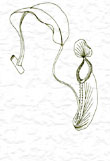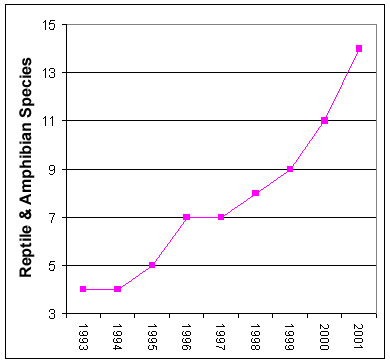

 |
 |
Vertebrates
New reptile and amphibian records for Kau Sai Chau, Sai Kung
by Thomas D. Dahmer, Kwok Hon Kai and Mary L. Felley, Ecosystems Ltd.
Introduction
Lau and Dudgeon (1999) listed records of amphibians on Kau Sai Chau based on surveys carried out there in May and September 1993. Monitoring of amphibians and reptiles on the island has been undertaken since that time, and has resulted in records of additional species, one of which is of local conservation concern. The purpose of this manuscript is to update the amphibian and reptile records for Kau Sai Chau as a contribution to the continuing development of the Hong Kong Special Administrative Region biodiversity survey.
Methods
Kau Sai Chau was surveyed on foot on 13 May and 14 September 1993 by a team from the University of Hong Kong Zoology Department that included Michael Lau, a specialist in Hong Kong reptiles and amphibians. The survey covered the northern third of the island that was to be developed into a golf course.
We surveyed the northern third of the island during 1993 and 1994 for an environmental impact assessment (EIA) of the proposed golf course. We recorded reptile and amphibian sightings over that time period and continued monitoring annually after completion of the golf course from 1995 to date, with support of the Hong Kong Jockey Club Kau Sai Chau Public Golf Course Ltd. Sightings were recorded by species, and specimens collected whenever necessary for identification. Surveys were carried out during day and night in spring and summer months. Frogs were identified aurally and visually. Support was received from the golf course staff, which greatly increased the survey effort. Specimen identifications were confirmed by Dr. M. Lau, Kadoorie Farm and Botanic Garden. Results of the monitoring and research studies have been documented in periodic reports to the Hong Kong Jockey Club (Ecosystems Ltd. 2000). Nomenclature used in this report follows that of Karsen .
Results
Reptile and amphibian records for Kau Sai Chau are listed in Table 1. The pre-construction records include 4 species, as compared to the post-construction total of 14 species. The increase in reptile and amphibian species records over 5.5 years of golf operation is shown in Figure 1. The new records include one species of toad, two frogs, one terrapin (exotic) and seven snakes. One pre-construction frog species has not yet been recorded post-construction (Three-striped Grass Frog Rana macrodactyla).
Discussion
Lau and Dudgeon (1999) reported 2 frogs on Kau Sai Chau. Of those, Günther’s Frog (Rana guentheri) is currently commonly seen and heard on the island, whereas the Three-striped Grass Frog has not been recorded since 1993 (surveys are underway to locate it). Two additional frogs have been recorded since 1993, the Brown Tree Frog (Polypedates megacephalus) and the Two-striped Grass Frog (Rana taipehensis). The latter has been recommended for statutory protection in Hong Kong based on its status as threatened or rare (ibid.).
No toad was reported by Lau and Dudgeon (1999), but the Asian Common Toad (Bufo melanostictus) has been reported since 1995, and is currently common and widespread on the island.
The only terrapin recorded on Kau Sai Chau is the introduced Red-eared Slider (Trachemys scripta elegans). It is now common in the ponds constructed for the golf course, but was not seen in 1993 when there were no ponds on the northern part of the island other than 2 small, coastal reservoirs used to store drinking water for occupants of mariculture sites.
The two gecko species reported by Lau and Dudgeon (1999) can still be seen on the island. Both are common around buildings and golf facilities.
The seven species of snake currently found on the island were not recorded in 1993. Of the six, the Indo-Chinese Rat Snake (Ptyas korros), the Bamboo Snake (Trimeresurus albolabris), and the Copperhead Racer (Elaphe radiata) are most commonly seen. The Chinese Cobra (Naja atra) is also abundant and widespread. The King Cobra (Ophiophagus hannah) is a recent addition to the species list and is not often seen. The Large-spotted Cat Snake (Boiga multomaculata) is also a recent addition to the list, but appears to be increasing in abundance. The Burmese Python (Python molurus bivittatus) was first recorded in 2000 after it apparently swam to Kau Sai Chau. It is not often seen, and only one individual is thought to occupy the island sporadically.
The apparent increase in species numbers since 1993 may in part reflect greater survey effort applied over an extended time period. However, golf course personnel and the authors concur that species and population numbers of reptiles (especially) and amphibians increased on the northern third of the island between 1993 and 2001.
Acknowledgements
Records of snakes were often reported by Cameron Halliday, Rick Hamilton, Paul Yip, and greenskeeping personnel at the Jockey Club Kau Sai Chau Public Golf Course. Their cooperation and assistance is greatly appreciated. The Large-spotted Cat Snake was identified by Dr. Michael Lau of Kadoorie Farm and Botanical Garden. Studies reported here were funded by the Jockey Club Kau Sai Chau Public Golf Course Ltd., whose support is gratefully acknowledged.
Bibliography
Ecosystems Ltd. (2000). Hong Kong Jockey Club Kau Sai Chau Public Golf Course Ecological Monitoring Report: July 1999 to June 2000.
Karsen, S. J., Lau, M. W. N., and Bogadek, A. (1998). Hong Kong Amphibians and Reptiles. Second Edition. Urban Council, Hong Kong
Lau, M. W. N. and D. Dudgeon. (1999). Composition and distribution of Hong Kong amphibian fauna. Mem. Hong Kong Nat. Hist. Soc. 22:1-80.
Ecosystems Ltd., 2/F Kingsun Computer Bldg., 40 Shek Pai Wan Road, Aberdeen, Hong Kong, ecosys@pacific.net.hk
Table 1. Reptiles and amphibians recorded before and after construction of the golf course on Kau Sai Chau.
|
Pre-Construction Records – May
1993 to May 1994
|
||
|
Class, Order, Family |
Scientific Name |
Year Recorded |
| Amphibia, Anura, Ranidae | ||
|
Günther’s Frog |
Rana guentheri |
1993 |
|
Three-striped Grass Frog |
Rana macrodactyla |
1993 |
|
Reptilia, Squamata, Gekkonidae |
||
|
Bowring’s Gecko |
Hemidactylus bowringii |
1993 |
|
Garnot’s Gecko |
Hemidactylus garnotii |
1993 |
|
Post-Construction Records –
July 1995 to present
|
||
|
Class, Order, Family |
Scientific Name |
Year Recorded |
|
Amphibia, Anura, Bufonidae |
||
|
Asian Common Toad |
Bufo melanostictus |
1995 |
|
Amphibia, Anura, Ranidae |
||
|
Günther’s Frog |
Rana guentheri |
1995 |
|
Two-striped Grass Frog |
Rana taipehensis |
2001 |
|
Amphibia, Anura, Rhacophoriidae |
||
|
Brown Tree Frog |
Polypedates megacephalus |
1996 |
|
Reptilia, Testudinae, Emydidae |
||
|
Red-eared Slider |
Trachemys scripta elegans |
2000 |
|
Reptilia, Squamata, gekkonidae |
||
|
Bowring’s Gecko |
Hemidactylus bowringii |
1995 |
|
Garnot’s Gecko |
Hemidactylus garnotii |
1995 |
|
Reptilia, Squamata, Boidae |
||
|
Burmese Python |
Python molurus bivittatus |
2000 |
|
Reptilia, Squamata, Colubridae |
||
|
Large-spotted Cat Snake |
Boiga multomaculatus |
2001 |
|
Copperhead Racer |
Elaphe radiata |
1998 |
|
Indo-Chinese Rat Snake |
Ptyas korros |
1995 |
|
Reptilia, Squamata, Elapidae |
||
|
Chinese Cobra |
Naja atra |
1999 |
|
King Cobra |
Ophiophagus hannah |
2001 |
|
Reptilia, Squamata, Viperidae |
||
|
Bamboo Snake |
Trimeresurus albolabris |
1996 |
Figure 1. Taxon accretion curve for reptiles and amphibians on Kau Sai Chau from 1993-2001.
 |
P.13-15
|
Porcupine! |
 Copyright © 2000 |